2020-12-21
[public] 442K views, 25.0K likes, dislikes audio only
The amount of metal some special plants are able to take up from the soil would be toxic enough to an average plant to kill it several times over.
LEARN MORE
**************
To learn more about this topic, start your googling with these keywords:
- Hyperaccumulator: a plant capable of growing in metalliferous soils and to accumulate extraordinarily high amounts of heavy metals, far in excess of the levels found in the majority of species, without suffering toxic effects
- Phytoremediation: the treatment of pollutants or waste (as in contaminated soil or groundwater) by the use of green plants that remove, degrade, or stabilize the undesirable substances (such as toxic metals)
- Phytomining: the planting (and subsequent harvesting) of vegetation that will selectively concentrate specific metals from the soil into their tissues
- Euhalophytes: highly salt-tolerant plants capable of diluting salt within their succulent leaves or stems
- Active transport: the process of transferring substances against a concentration gradient into, out of, and between cells, using energy
If you liked this week’s video, you might also like:
Read about a farm that is harvesting nickel-hoarding plants profitably: https://www.nytimes.com/2020/02/26/science/metal-plants-farm.html
Thank you to Dr. Hendrik Küpper for his expert consultation on the script! Learn more about his research into "metal-hoarding" plants here: https://plantmetals.eu/
SUPPORT MINUTEEARTH
**************************
If you like what we do, you can help us!:
- Become our patron: https://patreon.com/MinuteEarth
- Share this video with your friends and family
- Leave us a comment (we read them!)
CREDITS
*********
Julián Gustavo Gómez (@TheJulianGomez) | Script Writer, Narrator and Director
Arcadi Garcia Rius | Illustration, Video Editing and Animation
Nathaniel Schroeder | Music
MinuteEarth is produced by Neptune Studios LLC
OUR STAFF
************
Sarah Berman • Arcadi Garcia Rius
David Goldenberg • Julián Gustavo Gómez
Melissa Hayes • Alex Reich • Henry Reich
Peter Reich • Ever Salazar • Kate Yoshida
OUR LINKS
************
Youtube | https://youtube.com/MinuteEarth
TikTok | https://tiktok.com/@minuteearth
Twitter | https://twitter.com/MinuteEarth
Instagram | https://instagram.com/minute_earth
Facebook | https://facebook.com/Minuteearth
Website | https://minuteearth.com
Apple Podcasts| https://podcasts.apple.com/us/podcast/minuteearth/id649211176
REFERENCES
**************
Andresen, Elisa, Edgar Peiter, and Hendrik Küpper. "Trace metal metabolism in plants." Journal of Experimental Botany 69.5 (2018): 909-954. https://academic.oup.com/jxb/article/69/5/909/4855954
Bouman, Roderick, et al. "Phyllanthus rufuschaneyi: a new nickel hyperaccumulator from Sabah (Borneo Island) with potential for tropical agromining." Botanical studies 59.1 (2018): 9. https://link.springer.com/article/10.1186/s40529-018-0225-y
Brooks, Robert R., et al. "Phytomining." Trends in plant science 3.9 (1998): 359-362. https://www.cell.com/trends/plant-science/comments/S1360-1385(98)01283-7
Chrispeels, Maarten J., Nigel M. Crawford, and Julian I. Schroeder. "Proteins for transport of water and mineral nutrients across the membranes of plant cells." The Plant Cell 11.4 (1999): 661-675. http://www.plantcell.org/content/11/4/661
Favas, Paulo JC, et al. "Phytoremediation of soils contaminated with metals and metalloids at mining areas: potential of native flora." Environmental risk assessment of soil contamination 3 (2014): 485-516. https://cdn.intechopen.com/pdfs/46355.pdf
Morgan, J. B. & Connolly, E. L. (2013) Plant-Soil Interactions: Nutrient Uptake. Nature Education Knowledge 4(8):2 https://www.nature.com/scitable/knowledge/library/plant-soil-interactions-nutrient-uptake-105289112/
Morrissey, Joe, and Mary Lou Guerinot. "Trace elements: too little or too much and how plants cope." F1000 biology reports 1 (2009). https://www.ncbi.nlm.nih.gov/pmc/articles/PMC2920677/
Rascio, Nicoletta, and Flavia Navari-Izzo. "Heavy metal hyperaccumulating plants: how and why do they do it? And what makes them so interesting?." Plant science 180.2 (2011): 169-181. https://doi.org/10.1016/j.plantsci.2010.08.016
Song, Jie, and Baoshan Wang. "Using euhalophytes to understand salt tolerance and to develop saline agriculture: Suaeda salsa as a promising model." Annals of Botany 115.3 (2015): 541-553. http://europepmc.org/backend/ptpmcrender.fcgi?accid=PMC4332605&blobtype=pdf
Yuan, Fang, et al. "Beneficial Effects of Salt on Halophyte Growth: Morphology, Cells, and Genes." Open Life Sciences 14.1 (2019): 191-200. https://www.degruyter.com/view/journals/biol/14/1/article-p191.xml
https://www.patreon.com/minuteearth
/youtube/channel/UCeiYXex_fwgYDonaTcSIk6w
https://patreon.com/minuteearth
/youtube/video/4DF94Wvtekk

